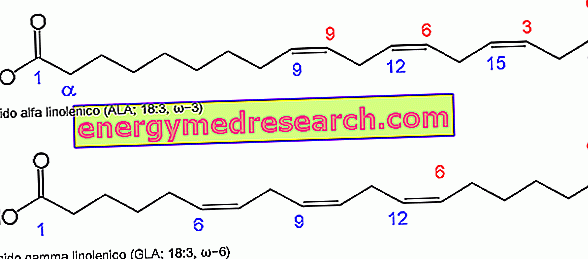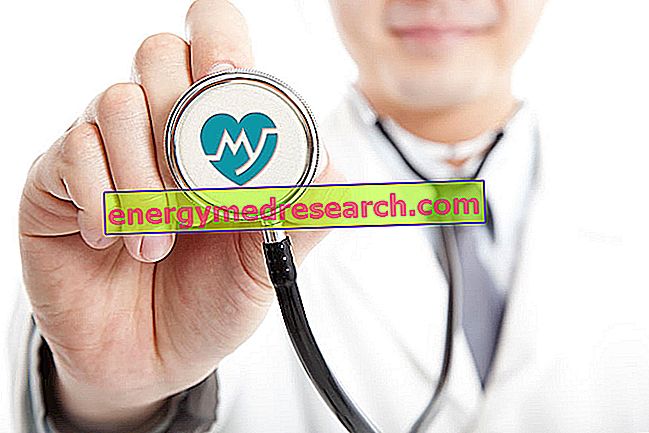Generality
In the articles on essential fatty acids of the omega six and omega three series, one often encounters the generic term linolenic acid .
In reality, when it comes to linolenic acid it is very important to specify if it is:
- Alpha linolenic acid, an omega three contained in fish and some vegetable oils, in particular in canola, hemp, soy, walnut, sage, kiwi and flax oil
- Gamma linolenic acid, an omega six contained in some vegetable oils, in particular in blackcurrant oil and borage oil
In fact, both the chemical structure and the metabolic role of the two fatty acids in the body are different.

We also recall that the term linolenic acid should not be confused with the term linoleic acid (LA; 18: 2, ω6).
We go into detail to better understand.
Alpha linolenic acid
Alpha linolenic acid (ALA) is an essential fatty acid known to be the progenitor of the omega three.
It is considered the most important of the omega 3 family because it is the only truly essential; in fact, starting from alpha linolenic acid, the human organism synthesizes two metabolically active semi essential fatty acids: eicosapentaenoic acid (EPA) and docosahexaenoic acid (DHA).
This transformation is not always completely effective (it can be compromised with old age, drug therapies, alcoholism, malnutrition, etc.).
EPA and DHA are important above all for their structural activity (cellular membrane and nervous as well as ocular tissue) and metabolic (anti-inflammatory, hypotriglyceridemizing, hypotensive, "blood thinner" etc.).
The nutritional source of these two semi-essential fatty acids is the foods that fall into the category of fishery products and their oils.
Gamma linolenic acid
Gamma linolenic acid (GLA) is a semi essential omega 6 fatty acid.
It is produced by the body using the parent molecule of the same group as a substrate, called linoleic acid (the conversion is enzymatic and uses the same catalyst as omega 3).
Even the production of gamma linolenic acid is not always completely effective, for the identical reasons we mentioned in the previous chapter.
This lipid is also present in foods, for example: hemp seeds, oats and barley, in spirulina algae, in borage oil, evening primrose, black currant seeds and of course hemp.
Gamma linolenic acid is in turn a precursor of diomo gamma linolenic acid (DGLA), the third direct source of eicosanoids (together with arachidonic acid - AA - and EPA). Specifically, DGLA appears to produce only one type of prostaglandin and one of thromboxane with an anti-inflammatory and immunomodulatory action.
However, we must not forget that from the DGLA the organism can further extract AA acid, in turn with a proinflammatory function.
Linoleic acid
Linoleic acid (LA) is an essential fatty acid with 18 carbon atoms, progenitor of the omega six, of which seed oils in general and olive oil are rich.
For some years it has been hypothesized that an excess of linoleic acid, typical of western food, in the face of a reduced intake of alpha linolenic acid, could be considered a risk factor for the development of diseases on an inflammatory basis, such as atherosclerosis and diseases. cardiovascular (heart attack, thrombosis, arrhythmia), rheumatoid arthritis, osteoporosis, mood disorders, cancer, diabetes and obesity.
In reality, this effect is more attributable to the excess of other omega 6, in particular arachidonic acid (AA - partially synthesized by the body starting from LA), which represents the most abundant polyunsaturated fatty acid in foods of animal origin .
To eliminate the risks of excess omega 6 and alpha linolenic acid deficiency, it is sufficient to consume 2-3 portions of sea fish, both fresh and frozen, per week. Particularly rich in alpha linolenic acid are fatty fish meats that inhabit cold sea waters, such as cod, salmon, tuna and mackerel, but also herring, sardines and blue fish in general; other excellent sources are fish oil, cod liver oil, krill oil and seaweed oil.
Indications
When to use alpha linolenic acid?

Supplements must be used especially when the diet is not able to compensate for nutritional needs.
Furthermore, it may be useful to increase the intake of linolenic acid, EPA and DHA to normalize some excess metabolic values, such as: arterial pressure, triglyceridemia, damage inflicted by hyperglycemia and type 2 diabetes mellitus etc.
Statistically, the deficit mainly affects EPA and DHA, which are even more important in the diet of the expectant mother, the nurse and the small child up to two years of life.
To ensure the intake of ALA, it is sufficient to consume the right portions of cereals, legumes, fruit and vegetables, to prefer the whole unprocessed forms, to eat at least 50% of the fruit and raw vegetables and, to be careful, partially replace the extra virgin olive oil with another rich in omega three (such as chia, flax, kiwi, etc.) to be used raw.
The demand for omega 3 increases with caloric expenditure and overall metabolic commitment; it is usually not necessary to use supplements based on alpha linolenic acid, while it seems useful to increase EPA and DHA (especially in the case of a vegetarian or vegan diet, intolerance to fish flavor supplements, etc.).
When to use gamma linolenic acid?
Currently, there is no known morbidity related to GLA deficiency, except those related to linoleic acid (LA).
In natural medicine, considering it useful for its anti-inflammatory action, gamma linolenic acid is prescribed against autoimmune diseases, arthritis, atopic dermatitis (classic indication) and premenstrual syndrome.
Gamma linolenic acid has an anti-inflammatory function mainly linked to the formation of DGLA; on the other hand, from the latter cellular metabolism is able to obtain even AA with inflammatory action.
It is likely that it is because of this promiscuity that integration with gamma linolenic acid does not offer clearly describable results.
Property and Effectiveness
What benefit has alpha linolenic acid shown during the studies?
Due to the reduced ability to synthesize EPA and DHA in the body, the health benefits of supplementing vegetable oils rich in alpha linolenic acid are far more contained than those obtainable through the consumption of fish oil or other supplements rich in EPA and DHA.
The functions of the latter two semi-essential fatty acids make their nutritional intake a real cure-all for the prevention and treatment of cardiovascular diseases, for the nervous and ocular development of the fetus and the child, for the maintenance of integrity and brain function in the geriatric age, for the fight against certain types of depression etc.
For more information see the dedicated article.
What benefit has gamma linoleic acid shown during the studies?
The usefulness of integration with gamma linolenic acid does not make use of scientifically proven tests.
Doses and Mode of Use
How much alpha linolenic acid do you take?
The minimum amount of alpha linolenic acid, essential for maintaining health, is not well defined.
Taking into account the recommendations of the LARN, alpha linolenic acid and other omega 3 should represent about 0.5-2.0% of total calories.
In an average adult's diet this percentage corresponds to 2-3 g per day.
Using a supplement (in liquid form or in capsules or opercula), it would be advisable not to exceed 3 g daily (which add up to the food content).
Remember that it is important to properly store these products by shielding them from light, oxygen and heat to keep their nutritional functions intact.
How much gamma linolenic acid do you take?
Since it is not totally essential and does not have an obvious metabolic impact, there are no specific recommendations regarding the minimum and maximum intake of GLA.
Side effects
The side effects of taking ALA and GLA are few and difficult to find.
Some are: gastrointestinal discomforts such as belching, nausea, abdominal cramps, dyspepsia and diarrhea (more frequent in the supplement with EPA and DHA).
Very rarely, blood clotting impairments have been observed.
Metabolic peroxidosis, as well as severe alterations of certain systems, is considered even more infrequent (linked above all to overdoses of any polyunsaturated fat).
Contraindications
When should alpha linolenic acid and gamma linolenic acid not be used?
The products based on ALA and GLA must be absolutely avoided in case of allergy or intolerance to the ingredients that compose them.
Moreover it is not recommended to combine them with certain pharmacological therapies (see below).
Pharmacological Interactions
Which drugs or foods can change the effect of alpha linolenic acid and gamma linolenic acid?
The use of ALA and GLA should be avoided in the case of pharmacological therapies based on:
- Anticoagulants (coumadin, sintrom, acenocumarol), aspirin, non-steroidal anti-inflammatory drugs, garlic and ginkgo biloba: they would increase the risk of bleeding due to the double anti-aggregating effect.
- Oral hypoglycemic agents: it is advisable to consult your doctor before starting the alpha linolenic acid supplement, even if the hypoglycemic power, mainly linked to the function of EPA and DHA, is not well defined and sometimes seems of little relevance.
Precautions for Use
What do you need to know before taking alpha linolenic acid and gamma linolenic acid?
First of all, it is advisable to consult a nutrition professional to assess the real need for a supplement based on ALA and GLA.
Secondly, it is essential to read carefully the composition, the side effects, the contraindications and the drug interactions.
Finally, although the integration of essential fatty acids plays a beneficial role in many situations (pregnancy, breastfeeding, replacement diseases, etc.) it is essential to consult a doctor before taking it.



